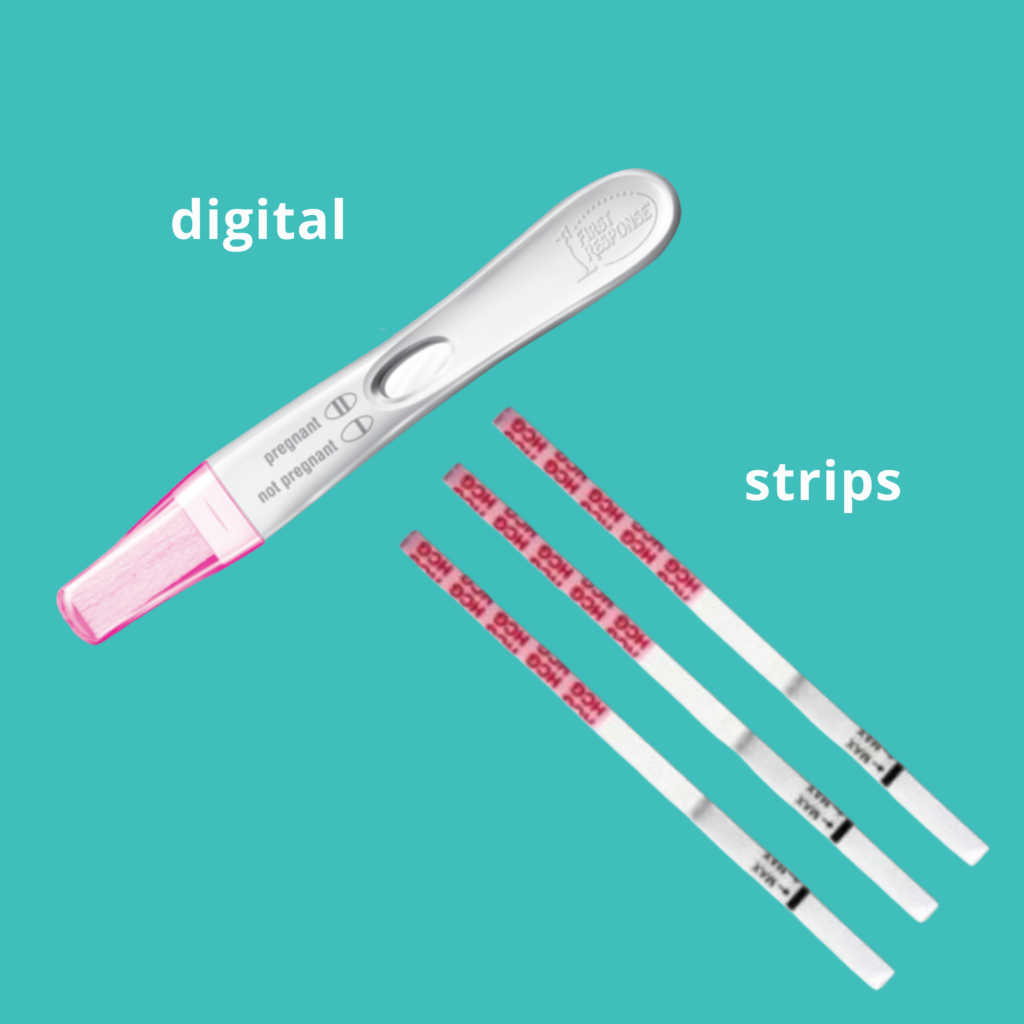There are a lot of decisions at every step on your journey toward a baby but this one might seem less important: which pregnancy test to choose. Sometimes making a little decision can make the whole process less overwhelming. I like it when something is finally easy for you because I’m been in your shoes (or at least somewhat).
With that in mind, here are a few things to consider and scroll down to see my personal experience.*
Reasons to buy a lot of pregnancy tests:
- You test early before your predicted period or beta blood test. You might be testing daily for a while depending on how early you try.
- Your period isn’t predictable. You might keep testing to make sure your ovulation wasn’t later or because it’s just hard to know when your expected period is. I have PCOS and irregular periods so this is me. Talk to your family or primary care doctor if this is you.
- You’re ‘testing out the hCG’ on a medicated cycle. This is where you had medication that replicated the pregnancy hormone and you test daily to see the line fade and then if there’s a positive, it slowly darkens again. If you’re only able to conceive through an IUI or IVF for your first try or tries, such as a medical reason or LGBQT+, then this something to ask your fertility doctor or nurse. It’s your choice whether to test at home. I would say have 15 or more at-home pregnancy tests on hand for a medicated cycle. Or, buy less and wait for your beta blood test.
- You plan to test a lot after a positive test. If you think you’ll want daily confirmation after a positive at home then you’ll test a lot and need 15 or more. You might be tracking if it’s darkening or fading and some people test in the morning and evening daily, but this is a personal choice. If you’re comparing a few, make sure it’s pink to pink dye or blue to blue dye (not pink vs blue) and take it the same time of day. Darkness change doesn’t mean the same increase like a blood test would show, so be cautious.
Deciding whether to buy digital tests vs. strip tests
When you buy pregnancy tests you have a choice of digital or strips. Let’s compare.

| Criteria | Digital | Strips | Getting into the details of why |
|---|---|---|---|
| Easy to use | Easier | Harder | Digital pregnancy tests take less effort to figure out than strips if it’s YES or NO. There’s the ease of seeing it digitized number instead of your objective read. You don’t have to squint and share the photo with others as much, which means there’s less room for you to tear your hair out and wonder, ‘Am I or not??’ But this isn’t always the case (see below malfunctioning). |
| How many steps | Fewer | More | You have to think more using the strips. But if you don’t follow the instructions, you can’t use them. If you don’t follow the instructions, you can’t use either of them but the strips are a big more work to interpret. |
| Cost | More expensive | Cheaper | Strips are cheaper than digital, especially if you buy in bulk. |
| Risk touch your pee | Less likely | More likely | Decide if you can handle peeing in a cup. If you use the strips you have to pee in a cup to do the test. If you use a digital one, you can do either pee on it and it’s less splashy and less likely to get pee on your hands, or you can pee in a cup to dip it too. Either way, you’ll scrub your hands clean after. |
| Eco friendly | Worse | Better | Strips are more environmentally friendly. Inside is the digital gadget surrounded by the strip (see the image below) and you have to put all of it in the trash – most people don’t take it apart to recycle the metal bits and the plastic parts aren’t usually recyclable. See below. |
| Quality | Good/ varies* | Good | All strips are essentially the same if you use them correctly and if they aren’t faulty. You can get them from a dollar store and they’re the same. You can buy them discretely online like Ovary, or on Amazon if that’s your jam (think if it matters what the values of the company you get them from matter.) The digital part of the digital tests vary in quality and have more room for error. The quality of the digital one varies based on the brand and just error of that particular test. There is literally a pregnancy strip inside the digital test, (see image below) it just has a little digital gadget around it and some plastic to make it easier to use and hold, distanced from the pee (a bit) but the digital part can be faulty. |
I personally mainly used strips but I used digital ones sometimes as a back up. It can get expensive to just use only digital ones and strips get really easy to use, so I used strips. When I wasn’t sure or wanted a ‘second opinion’, I did the digital after. I used about 8 strips and 0 to 2 digital ones a month. If you have a few different kinds on hand it can give you some peace of mind.
If you do have a positive, you might enjoy having a digital one to take a photo of to remember it. If it ends in a loss, it can go either way to have that keepsake.

Deciding whether to buy the pink or blue dye tests
Some people prefer the ones with pink dye over the blue dye. The dye can be either colour and it’s definitely your preference. Anecdotally, I would say more people like the pink dye ones because they tend not to have the evaporation line as much but there’s no evidence of that to date.
To do before you test
- Follow the instructions carefully. Look at the test within the time frame (usually 3 to 5 minutes) the instructions say, otherwise you might get an evaporation line, which makes it look like a positive when in fact it might be a negative result. It can be heart wrenching.
- Talk to your pharmacist about any medications you’re taking that might make your pregnancy test give a false positive (it looks like a positive result but it’s not actually)
- If you are plus-sized then keep in mind that you might find the at-home pregnancy tests are not as accurate. Studies have shown that if you weigh more and in particular considered medically obese (use the language that suits you) you might have lower level hCG detected thantwould normally be a marker of a low level when it’s normal for you. In these studies, the findings show that the lower level serum ended up with a live birth more often than with those who weren’t obese. This means that if your line is faint or your blood test isn’t high then be more cautiously optimistic if you are obese that the numbers don’t reflect the true chances of success. It’s a bias in the product and adds to the stress, unfortunately!
- If you’re just starting to use pregnancy tests for the first time then you’re not alone if you’ve found it a bit overwhelming. That’s normal, this is new.
When to test
- Tests may show a positive 4 days before your predicted period, according to studies.
- If you’re doing an unmedicated embryo transfer, the soonest you could see a positive is usually 5 days after transfer. It could be 4 days, but it could be closer to 9, time will tell.
- A beta blood test is more accurate than an at-home pregnancy test. The at-home pregnancy test can detect only if there is about 20 hCG in your urine whereas the beta pregnancy blood test can detect even 1 hCG or anything above zero. Definitely it can differ where you get that test done but it’s generally more accurate than an at-home test, although if you follow the directions a positive is usually a positive unless it’s not a viable pregnancy (now or eventually).
Considerations if you’ve had or are having fertility struggles
- You can have a positive test result even if you’ve had a chemical pregnancy, a miscarriage or an ectopic pregnancy or Pregnancy of Unknown Location (PUL). It’s incredibly heartbreaking and can be a long and complex road ahead if you know you’ve had a loss but the hCG isn’t decreasing. You’ll need your doctor to be notified right away and advice on your action plan.
- If you’re struggling to get then these tests can get harder and heavier on your heart. That’s normal to struggle with your mental health if you’re not getting pregnant month after month when you want to. Please consider seeking professional support.
- If you’re struggling to maintain a pregnancy or you’re trying after a loss or losses then these tests can come with a lot of complex emotions and anxiety. You’re not alone.
You’ve got me if you need some expert support and coaching on any aspect of your fertility journey.

References
Brady PC, Farland LV, Ginsburg ES. Serum Human Chorionic Gonadotropin Among Women With and Without Obesity After Single Embryo Transfers. J Clin Endocrinol Metab. 2018 Nov 1;103(11):4209-4215. doi: 10.1210/jc.2018-01057. PMID: 30137414.
Gnoth C, Johnson S. Strips of Hope: Accuracy of Home Pregnancy Tests and New Developments. Geburtshilfe Frauenheilkd. 2014 Jul;74(7):661-669. doi: 10.1055/s-0034-1368589. PMID: 25100881; PMCID: PMC4119102.
